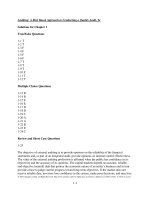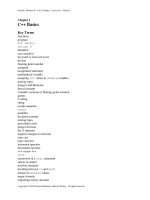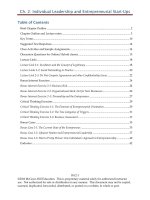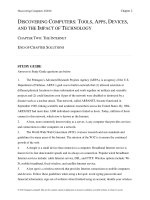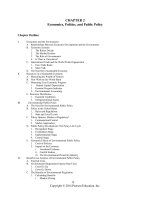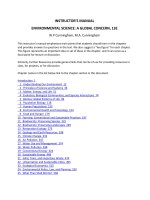Test bank and solution manual of college physics (2)
Bạn đang xem bản rút gọn của tài liệu. Xem và tải ngay bản đầy đủ của tài liệu tại đây (1.42 MB, 59 trang )
Giordano: CP 2e ISM, Vol 1
1
CH02
2 Motion, Forces, and Newton’s Laws
CONCEPT CHECK
2.1 | Force and Motion
The motion in (a) is inconsistent with Aristotle’s law of motion, Equation 2.1, since the puck slides without any force propelling it in the direction of its velocity, and (b) is inconsistent with Equation 2.1 for the same reason. The motion in (c)
does appear to be consistent with Aristotle’s law of motion because a piano will generally stop moving as soon as the force is
removed.
2.2 | Estimating the Instantaneous Velocity
Yes, there is a value of t at which the velocity is zero in Figure 2.9. The instantaneous velocity is equal to the slope of the
x – t graph, and this slope is zero at t ≈ 1.6 s in Figure 2.9.
2.3 | The Relation between Velocity and Position
Velocity is the slope of the x – t curve.
(a)
The slope and velocity increase with time for graph 3 in
Figure 2.13.
(b)
The slope and velocity decrease with time for graph 2.
(c)
The slope and velocity are constant (do not change with
time) for graph 1.
2.4 | Analyzing a Position–Time Graph
The correct answers are (b) and (d). To understand the motion
described by an x – t graph, consider the behavior of the velocity as found from the slope of the x – t plot. In Figure 2.18,
this slope—and therefore the velocity—are largest at early times
and fall to zero at the end of the motion. Hence, this object is
slowing to a stop.
2.5 | Finding the Velocity
The answer is (b) Curve 2. The velocity at any point along the
displacement time curve is the slope of a tangent line at that
point. This slope starts positive at t = 0, grows less and less
Giordano: CP 2e ISM, Vol 1
2
CH02
positive until it is zero at the highest point, and then becomes
increasingly negative, just as curve 2 does.
2.6 | Action–Reaction Force Pairs
The two forces in an action–reaction pair must act on the two
objects involved in an interaction. Hence, the forces in (a) are
not an action–reaction pair because the pitcher does not act directly on the bat. For the same reason, the forces in (c) are
not an action–reaction pair. The forces in (b) are an action–
reaction pair because they involve the two “objects” (your hands
and the wall) that are involved in the interaction.
QUESTIONS
Q2.1 See Figure Qans 2.1.
Figure QAns 2.1
This sketch represents an object ejected from a planet into
space, for example from Earth’s surface. If the initial velocity
is large enough, the object will always have a positive velocity. However, the acceleration is always negative (pointing toward the planet), so the velocity will diminish, but never reach
zero.
Q2.2 Graphs for parts (a) and (b) are sketched below:
Giordano: CP 2e ISM, Vol 1
3
CH02
Figure QAns 2.2
(c)
On the trip upward, it has a positive (upward) velocity,
which is getting smaller in magnitude. (We would say the
ball is slowing down.) This represents a negative change in
velocity over time, or a negative acceleration. On the way
down, the ball has a downward (negative) velocity which is
INCREASING in magnitude. This also represents a negative
change in velocity over time—or a negative acceleration,
even though the ball is now “speeding up”!
Q2.3 See Figure QAns 2.3.
Figure QAns 2.3
The wall provides the force on the car to cause it to stop. The
reaction force is the force provided by the car on the wall
which may do damage to the wall.
Q2.4 See Figure QAns2.4.
Giordano: CP 2e ISM, Vol 1
4
CH02
Figure QAns 2.4
According to Newton’s second law, the acceleration of the refrigerator is due to the sum of the forces on the object. Your
push is countered by a frictional force of equal magnitude and
opposite direction. Here the forces on the refrigerator sum to
zero, so the net force on the refrigerator is zero, thus making
the acceleration of the refrigerator zero as well. Newton’s second law applies to the net force on an object, not just to the
force you apply to the object.
Q2.5 According to Newton’s first law, the only way the velocity
of an object can change is if there is a net force on the object. A car changes speed and/or direction when its tires experience a force exerted by the road. If the road is too slippery,
the tires can no longer apply these forces and therefore the velocity of the car does not change.
Q2.6 If the wheels of the car are slipping, they cannot apply
any forces in the horizontal direction. Because there are no net
forces on it, the car will remain at rest.
Q2.7 For an object orbiting at a constant speed about the origin
(say a ball on the end of a string), the average velocity will
be zero around the center point, but the speed will never
change. A race car driving around an oval track is another example.
Q2.8 See Figure QAns2.8. An example of such a motion is when an
object is moving at a constant speed in one direction.
Giordano: CP 2e ISM, Vol 1
5
CH02
Figure QAns 2.8
[SSM] Q2.9 Abracadabra! The place–settings are initially at rest
(that is they have an initial velocity of 0 m/s). The principle
of inertia states that a body will move with constant velocity
unless acted upon by a force. Here the pulling of the tablecloth
out from under the place–settings is done so quickly that the
force and any associated acceleration on them is very small, and
thus the place–settings barely change their velocity from 0.
Q2.10
(a)
A spaceship leaving the surface of a planet, accelerated
under the power of its engines.
(b)
An apple falling from a tree.
(c)
A car coming to rest as it approaches a stop light.
Q2.11 Yes it is possible. This happens all the time on race
tracks. The cars start at the origin at t = 0. After just completing a lap, they have a positive velocity, but they are back
at the origin, i.e., the displacement is zero.
Q2.12
(a)
Yes. The object’s acceleration is a constant value, and so
is the same at all times. This makes the average acceleration the same as the acceleration at any instant.
(b)
Figure QAns 2.12b
(c)
No. As seen in answer (b), the velocity grows more negative
with time. The average velocity over an arbitrary interval
Giordano: CP 2e ISM, Vol 1
6
CH02
is therefore not equal to the velocity at any instant.
Q2.13 See Figure QAns 2.13.
Figure QAns 2.13
Note the
ground.
large
positive
Q2.14 See Figure QAns 2.14.
acceleration
as
the
ball
hits
the
Giordano: CP 2e ISM, Vol 1
7
CH02
Figure QAns 2.14
The force on the yo–yo is nonzero except for two instants in
time when the acceleration reverses direction, as seen where the
acceleration vs. time curve passes through zero.
[SSM] Q2.15 See Figure QAns 2.15.
Figure QAns 2.15
Q2.16
(a)
Yes the person is exerting a force on the ball in order to
Giordano: CP 2e ISM, Vol 1
8
CH02
accelerate it upward. After the ball leaves his hand, he
exerts no force on the ball.
(b)
Yes the ball exerts a force on the person according to Newton’s third law of motion. The direction of this force is
downward.
(c)
The person does not accelerate because the Earth exerts an
equal and opposite upward force on the person. The net
force on the person is zero.
Q2.17
(a)
The Moon’s acceleration is nonzero. The Moon’s speed may be
pretty close to constant, but its direction is changing at
every instant in time, so it must be accelerating.
(b)
The force responsible for the Moon’s acceleration is the
gravitational force the Earth exerts on the Moon.
Q2.18 If there is no acceleration, then there is no net force.
In the case of the marble in honey it means that the forces acting on the marble are equal but opposite in direction, so when
summed as vectors they are equal to zero. In this case the force
of gravity is exactly equal and opposite to the drag force.
Q2.19
(a)
Because the surface is frictionless, there are no horizontal forces and so the horizontal velocity is constant. The
vertical forces (weight and normal force) do not affect the
puck’s horizontal motion.
(b)
Because the surface has friction, velocity is not constant,
and the mug will accelerate opposite its motion.
(c)
Because the surface has friction, velocity is not constant,
and the car will accelerate opposite its motion.
Q2.20
(1)
The force exerted on block 1 by the table, and the force
exerted on the table by block 1.
(2)
The force exerted on block 2 by block 1 and the force exerted by block 2 on block 1.
(3)
The force exerted on block 3 by block 2 and the force exerted by block 3 on block 2.
Giordano: CP 2e ISM, Vol 1
9
CH02
Q2.21 See Figure QAns2.21.
Figure QAns 2.21
Q2.22 If we let the direction the car is traveling be the positive direction, then:
(a)
When the car is speeding up, the net force is in the positive direction.
(b)
When the car is slowing down, the net force is in the negative direction.
(c)
When the car moves at a constant speed, the net force is
zero.
PROBLEMS
P2.1 Recognize the principle. Apply dimensional analysis.
Sketch the problem. No sketch needed.
Identify the relationships. Dimensions of v :
Solve. Since
velocity
is
a
distance
per
L
T
time,
we
can
see
(a), (d), (e), and (f) are all velocities.
(c)
is not because it is distance cubed per distance squared
Giordano: CP 2e ISM, Vol 1
10
CH02
multiplied by time squared, or distance per time squared,
which is an acceleration.
(b)
is not because it is distance per time squared, which is an
acceleration.
(g)
is not because it will be dimensionless, since it is a distance per distance.
What does it mean? Dimensional analysis should be used to check
answers for appropriate units.
P2.2 Recognize
1.4)
the
principle. Apply
unit
conversion.
(Section
Sketch the problem. No sketch needed.
Identify the relationships. Using the conversion 1 mi/h = 0.447
m/s, we can convert the miles per hour to m/s.
Solve. The solution to two significant figures is:
0.447 m/
400 mi/ h
1 mi/ s
s
180 m/ s
What does it mean? Note that 1 m/s is approximately 2 mi/h.
P2.3 Recognize the principle. Apply dimensional analysis.
Sketch the problem. No sketch needed.
Identify the relationships. Dimensions of a :
L
T2
Solve. Since acceleration is a distance per time squared, we can
see (b), (c), (d), and (f) are all accelerations. Choice (c) is an acceleration because distance is cubed in the numerator and squared
in the denominator. This cancels to leave distance in the numerator and time squared in the denominator, which are the dimensions of acceleration.
(a)
is not because it represents distance per time, which is a
velocity.
(e)
is not because it also represents distance per time, which
is again a velocity.
Giordano: CP 2e ISM, Vol 1
11
CH02
What does it mean? Dimensional analysis should be used to check
answers for appropriate units.
P2.4 Recognize
1.4)
the
principle. Apply
unit
conversion.
(Section
Sketch the problem. No sketch needed.
Identify the relationships. Looking up the conversion 1 m = 3.28
ft and applying this, we can calculate the acceleration in ft/s2.
Solve.
3.28 ft
a 9.8 m/ s 2
32 ft/ s 2
1m
What does it mean? This is the average value of the gravitational
acceleration,
the
downward acceleration near the Earth’s surface. You will use
this acceleration frequently in future chapters.
P2.5 Recognize the principle. The
distance traveled per time.
average
speed
is
the
total
Sketch the problem. No sketch needed.
Identify the relationships. The average speed is defined by:
v ave
d
t
Solve. Inserting the given values:
v ave
1500m
7.0 m/ s
215 s
What does it mean? Since speed is a distance per time, this
tells us nothing about the direction in which the runner moved.
* [Life Sci] P2.6 Recognize the principle. Apply graphical analysis of motion, including the definitions of velocity and acceleration.
Sketch the problem. See Figure Ans 2.6.
Giordano: CP 2e ISM, Vol 1
12
CH02
Figure Ans 2.6
Identify the relationships. Use the graphical techniques as discussed in Section 2.2.
Solve. See Figure Ans2.6. The runner will want to quickly accelerate (large positive acceleration, assuming the direction down
the track is positive). Then assume approximately constant velocity until the finish, followed by a more gradual slowdown after the finish line (smaller negative acceleration).
What does it mean? While these graphs assume constant velocity
during most of the race, the runner’s strategy might involve a
further acceleration before the finish.
* P2.7 Recognize
2.2)
the
principle. Analysis
of
motion.
(Section
Sketch the problem. No sketch needed.
Identify the relationships. His average velocity can be found
using the definition of average velocity: the total distance
traveled, x tot , divided by the time it took to travel that distance, t tot t 1 t 2 t 3
Solve.
(a)
x tot x 1 x 2 x 3 200 m + 0 m + 50 m = 250 m
Giordano: CP 2e ISM, Vol 1
x 1
13
CH02
x 1
200 m
67 s, t 2 30 s
v1
3.0 m/ s
and
x 3
50 m
14 s
v3
3.5 m/ s
t 1 t 2 t 3 67 s + 30 s + 14 s = 111 s
t 3
t tot
v ave
x tot 250 m
t tot
111s
v ave 2.3 m/ s
(b)
The minimum velocity was when he was waiting at the
stoplight,
v min 0 m/ s , and the maximum was
The average was
3.5 m / s .
closer to the maximam.
What does it mean? Note that the jogger did not run at the average velocity for any significant period of time (perhaps only an
instant). This problem is useful in illustrating the difference
between an average velocity and instantaneous velocity. The fact
that the 30 seconds of zero velocity is included in the average
makes an important point.
* P2.8 Recognize the principle. Apply graphical analysis of motion, including the definitions of velocity and acceleration.
Sketch the problem. See Figure Ans 2.8.
Giordano: CP 2e ISM, Vol 1
14
CH02
Figure Ans 2.8
Identify the relationships. Use the graphical techniques as discussed in Section 2.2.
Solve. See Figure Ans2.8. These graphs are sketched assuming
that the direction of motion of the puck is the positive direction. The frictional force (and acceleration) will be nearly
constant for this motion.
What does it mean? Note that the acceleration is negative because the puck is moving in the positive direction and slowing
down. The acceleration caused by friction will only exist until
the puck comes to rest.
* P2.9 Recognize the principle. Apply graphical analysis of motion.
Sketch the problem. See Figure Ans2.9.
Giordano: CP 2e ISM, Vol 1
15
CH02
Figure Ans 2.9
Identify the relationships. Use the graphical techniques as discussed in Section 2.2.
Solve. See Figure Ans2.9. Here the acceleration is not constant.
What does it mean? After accelerating at first, the marble descends in the molasses at a constant velocity.
* P2.10 Recognize the principle. Apply graphical analysis of motion, including the definitions of velocity and acceleration.
Sketch the problem. See Figure Ans 2.10.
Giordano: CP 2e ISM, Vol 1
16
CH02
Figure Ans 2.10
Identify the relationships. Use the graphical techniques as discussed in Section 2.2.
Solve. See Figure Ans2.10, which is sketched assuming that the
direction of motion is in the positive direction. Here the acceleration is not constant.
What does it mean? If the skateboard has very low friction, the
motion has close to zero acceleration except for the short time
interval when the rider pushes on the ground.
* P2.11 Recognize the principle. Apply graphical analysis of motion.
Sketch the problem. See Figure Ans 2.11.
Giordano: CP 2e ISM, Vol 1
17
CH02
Figure Ans 2.11
Identify the relationships. Use the graphical techniques as discussed in Section 2.2.
Solve. See Figure Ans2.11.
What does it mean? Here the acceleration is not constant. It actually reverses direction for a short time when the chute is
first opened and then goes to zero. Note that zero acceleration
does not imply zero velocity. The final velocity (before touch
down) is called terminal velocity.
* P2.12 Recognize the principle. Apply graphical analysis of motion, including the definitions of velocity and acceleration.
Sketch the problem. See Figure Ans 2.12.
Figure Ans 2.12
Giordano: CP 2e ISM, Vol 1
18
CH02
Identify the relationships. Use the graphical techniques as discussed in Section 2.2.
Solve. See Figure Ans2.12.
What does it mean? The actual amount of acceleration (rate of
change of speed) that the skier will experience depends on the
slope of the ground under her skis at each position on the hill.
Note that the speed is not necessarily zero at the top of the
hill.
[SSM] * P2.13 Recognize the principles. Since the dots represent
the location of an object between equal time intervals, then as
the object’s speed increases the spacing between the dots also
increases. Similarly, as the object slows down the spacing between the dots decreases.
Sketch the problem. Figure P2.13 provides the diagrams to analyze. Figure Ans2.13 provides sketches of the motion as part of
the solution to the problem.
Identify the relationships. The diagrams in Figure P2.13 give
the position of the object as a function of time. Graphs of x
vs. t can be made using these diagrams. Then, the velocity is
the rate of change of position (slope of the tangent to the x
vs. t curve), and the acceleration is the rate of change of velocity (slope of the tangent to the v vs. t curve).
Solve. See Figure Ans 2.13(1–3).
Figure Ans 2.13
Giordano: CP 2e ISM, Vol 1
What does it
ries of dots
to determine
tion vary as
19
CH02
mean? It’s rather impressive to see that from a serepresenting the positions of an object we’re able
how the object’s position, velocity, and accelerafunctions of time!
* P2.14 Recognize the principle. Apply graphical analysis of motion, including the definitions of velocity and acceleration.
Sketch the problem. See Figure Ans 2.14.
Figure Ans 2.14
Identify the relationships. Use the graphical techniques as discussed in Section 2.2.
Solve. In Figure Ans2.14, the positive direction is taken as the
direction of her motion. Therefore, the acceleration when her
brakes are applied is negative.
What does it mean? Note that if all other friction is negligible, the acceleration is zero when the bike is coasting at either speed, and negative when the bike is slowing down.
* P2.15 Recognize the principle. Apply graphical analysis of motion, in particular the definition of instantaneous velocity as
the slope of the tangent line drawn to the position vs. time
curve.
Giordano: CP 2e ISM, Vol 1
20
CH02
Sketch the problem. See Figure Ans 2.15.
Figure Ans 2.15
Identify the relationships. Use the graphical techniques as discussed in Section 2.2.
Solve. See Figure Ans 2.15.
What does it mean? Note that in Cases 1 and 2, at least part of
the motion is toward the origin (negative velocity), while in
Case 3, the motion is always away from the origin.
* P2.16 Recognize the principle. Note: This is an open-ended
problem with no unique answer. Apply graphical analysis of motion, including the definitions of velocity and acceleration.
Sketch the problem. Use Figure P2.15.
Identify the relationships. Use the graphical techniques as discussed in Section 2.2.
Solve.
(1)
This object started from rest, moved in the negative x
direction and then ended at rest at a closer distance to
the origin. This could be a car at rest at its destination,
beginning its journey back home at a constant velocity and
Giordano: CP 2e ISM, Vol 1
21
CH02
ending at rest, where the positive direction is from home
to its destination.
(2)
This object was headed in the positive x direction at a
constant speed, reversed its direction, and headed back to
its original position at a constant speed. It could be a
ball heading toward a tennis racket, and hit back at a
somewhat faster speed. The positive direction is toward the
racket.
(3)
This object looks like it has a steadily increasing
velocity, and a constant, positive acceleration. It could
be a rocket moving with constant acceleration in space.
What does it mean? While a sketch of a position vs. time graph
cannot tell you exact information about the velocity and acceleration of an object, it can give you an idea about these quantities.
* P2.17 Recognize the principle. Apply graphical analysis of motion, in particular the definition of the instantaneous acceleration as the slope of the tangent line to the velocity vs. time
curve.
Sketch the problem. See Figures P2.17 and Ans 2.17.
Figure Ans 2.17
Giordano: CP 2e ISM, Vol 1
22
CH02
Identify the relationships. Use the graphical techniques as discussed in Section 2.2.
Solve. See Figure Ans 2.17.
What does it mean? Note that in Case 2, the velocity is always
decreasing, while in Case 3 the velocity is always becoming more
negative. Both of these situations are represented by a negative
acceleration. Only in Case 1 does the velocity increase during
part of the motion, and this is the only Case in which a portion
of the acceleration vs. time graph is positive.
* P2.18 Recognize the principle. Apply graphical analysis of motion, including the definitions of velocity and acceleration.
Sketch the problem. See Figures P2.17 and Ans 2.18.
Identify the relationships. Use the graphical techniques as discussed in Section 2.2.
Solve. See Figure Ans 2.18 for one possible answer. The slope of
the position vs. time graph at any time must correspond to the
instantaneous velocity at that time.
Figure Ans 2.18
Giordano: CP 2e ISM, Vol 1
23
CH02
What does it mean? Notice that the velocity vs. time graph does
not tell you the position at the initial time. In other words,
the graphs in Figure Ans 2.18 are not unique, but could be
shifted up or down by the initial position value.
* P2.19 Recognize the principle. Note: This is an open-ended
problem with no unique answer. Apply graphical analysis of motion.
Sketch the problem. See Figure P2.17.
Identify the relationships. Use the graphical techniques as discussed in Section 2.2.
Solve
Case 1: An example is a car starting from a traffic light (at
rest), accelerating to the speed limit, and then traveling at
that speed.
Case 2: An example is a car slowing to a stop at a traffic
light. Note that the acceleration is not constant here, so the
car slows down rapidly at first, and then more and more slowly.
Case 3: An example is a ball thrown upward. The ball starts with
some initial velocity that decreases linearly due to gravity.
The ball stops at the top, then reverses direction and falls
downward, with an ever increasing speed (more negative velocity).
What does it mean? A velocity vs. time graph yields considerable
information about the motion of an object.
* P2.20 Recognize the principle. Apply graphical analysis of motion, including the definitions of velocity and acceleration.
Sketch the problem. See Figures P2.20 and Ans 2.20 for one possible answer.
Giordano: CP 2e ISM, Vol 1
24
CH02
Figure Ans 2.20
Identify the relationships. Use the graphical techniques as discussed in Section 2.2.
Solve. See Figure Ans 2.20. The slope of the velocity vs. time
graph at any time must correspond to the instantaneous acceleration at that time.
What does it mean? Notice that the acceleration vs. time graph
does not tell you the velocity at the initial time. In other
words, the graphs in Figure Ans 2.20 are not unique, but could
be shifted up or down by the initial velocity value.
* P2.21 Recognize the principle. Apply graphical analysis of motion.
Sketch the problem. See Figures P2.20.
Identify the relationships. Use the graphical techniques as discussed in Section 2.2.
Solve.
(1) A driver keeps his foot steady on the gas pedal to keep the
car moving at constant acceleration. The driver then shifts
gears and the car is still accelerating, but the value of a is
then smaller than at the start.
Giordano: CP 2e ISM, Vol 1
25
CH02
(2) A motorist applies his brakes so as to slow down to match
the speed of a car in front of him. Afterwards the motorist
continues at constant speed.
(3) An example is a car moving at constant velocity in a lane on
the freeway when the driver decides to momentarily accelerate
and change to a faster-moving lane. The driver then continues at
a constant, but greater speed.
What does it mean? Notice that only in Case 2 is there a region
in which the motion is slowing down. Even though Cases 1 and 3
have accelerations that increase and/or decrease, the acceleration is always positive or zero.
* P2.22 Recognize the principle. Apply graphical analysis of motion, including the definition of velocity.
Sketch the problem. See Figure P2.22.
Identify the relationships. Use the graphical techniques as discussed in Section 2.2.
Solve.
(a)
A person beginning a race is accelerating from rest,
perhaps with a nearly constant acceleration. Because the
slope of the tangent to Case 2 is increasing, this
corresponds to an increasing velocity.
(b)
After crossing the finish line, a runner is slowing down
until she is at rest. Because the slope of the tangent to
Case 4 is decreasing, this corresponds to a decreasing
velocity.
(c)
Only Case 3 represents motion in which the position
decreases and then increases several times. Thus, this must
represent the bouncing ball.
(d)
After leaving a bowler’s hand, the ball will roll down the
alley with a velocity that is nearly constant. Case 1 has a
constant slope, indicating a constant velocity.
(a) Case 2, (b) Case 4, (c) Case 3, and (d) Case 1
What does it mean? By examining the slope of the tangent at
points on a position vs. time graph, it is possible to determine
how the velocity is changing. This tells a lot about the motion.
